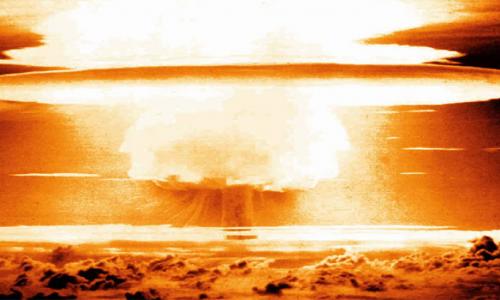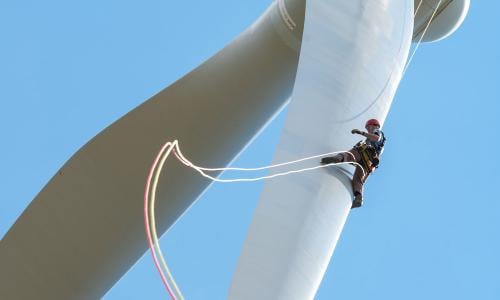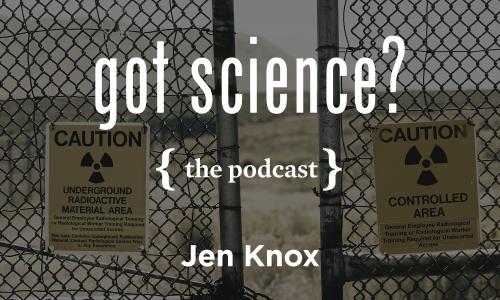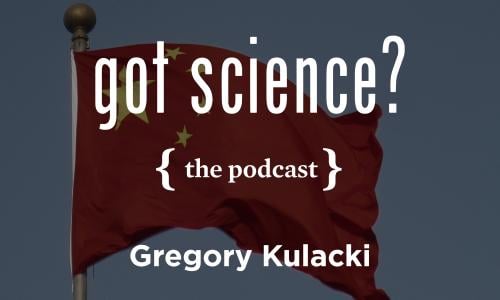Dr. Dick Garwin, recipient of the Presidential Medal of Freedom, discusses his work developing the hydrogen bomb, GPS, and touch screens.
In this episode
- Colleen and Dick discuss the creation of thermonuclear weapons
- Dick talks about his work on the Global Positioning System (GPS)
- Dick explores the ethics behind the question "Are there any areas of science that shouldn't be explored?"
Timing and cues
- Opener (0:00-0:30)
- Intro (0:30-2:36)
- Interview part 1(2:36-12:18)
- Break (12:18-13:18)
- Interview part 2 (13:18-24:58)
- This Week in Science History Throw (24:58-25:02)
- This Week in Science History (25:02-27:40)
- Outro (27:40-28:39)
Related content
Show credits
This Week in Science History: Katy Love
Editing and music: Brian Middleton
Research and writing: Jiayu Liang and Pamela Worth
Executive producer: Rich Hayes
Host: Colleen MacDonald
Transcript
Colleen: Dick, welcome to the Got Science Podcast.
Dr. Garwin: Good to be here.
Colleen:
Dr. Garwin: You gotta call me something.
Colleen:
Dr. Garwin: My involvement with Enrico Fermi started in spring of 1947 when I began my graduate work in physics at the University of Chicago. I had just graduated from Case Institute of Technology, now Case Western Reserve in Cleveland. Had just gotten married to my wife of what would be 70 years. She died a year ago. And we moved together to Chicago for my graduate work.
I was an experimenter, and my father had a shop in the garage of a newly built house in Cleveland in 1940. And he did audio and visual work for the schools and business in the Cleveland area. And I helped, you know, after school in high school and weekends and whatnot. So I was familiar with using my hands and electronics and whatnot. After a few months in graduate school at Chicago, I got itchy, there was no lab work. And so I went to one of the Professors, Fermi, and I said, look, I'm really good at this maybe I could help you. And he took me on. So I finished my Ph.D. in December of 1949, and I was appointed to the faculty in Physics at the University of Chicago.
But they only paid nine months a year. And by then, I had a six-month-old baby, and my wife and the baby and I ate 12 months a year. So when Fermi said, "Perhaps you could come with me and be a consultant to Los Alamos." I jumped at the chance and was wonderful because it's small community in the mountains of New Mexico. So we went in June 1950 for three months. And in 1951 for four months, and in 1952 for five months. At which time, I decided that I didn't really like particle physics anymore with the Chicago Cyclotron.
And I had a job interview for a new Solid State Physics Laboratory at Columbia University, operated by IBM. So I began my 40-year career with IBM in the New York area in December 1952. But by then, I had been for three months at Los Alamos, my wife says that I had spoken with Fermi about some suggestions for nuclear weapons. And he said that we couldn't talk about that in Chicago, but if I came to Los Alamos we could. So I did. And I spent the first week reading in the classified report library, all of the weekly progress reports during the war. And in the five years, following the August 1945, use of nuclear weapons against Hiroshima and Nagasaki. So I knew everything about the nuclear weapons of the time.
Colleen:
Dr. Garwin: Most of the famous people who were there during the war left in 1945 to go back to their universities and pick up their scientific research. So, people who were there full-time: Hans Bethe from Cornell, Edward Teller who then was recruited to the University of Chicago Fermi himself, had only come, I think, in 1944 because he was busy at Chicago designing the plutonium production reactors for the Hanford Site in Washington state.
Colleen:
Dr. Garwin: Yeah, my first summer actually looking at the program for making thermonuclear weapons, which had been the same ever since 1942. Very poorly funded, only Edward Teller and a couple of colleagues were working on it. By design, he was denied more resources. And that was right because in the war, an efficient weapon, a nuclear weapon, destroying whole city of Hiroshima or Nagasaki, was big enough. And the only way to make our thermonuclear weapon that gets its energy by combining light elements, heavy hydrogen-deuterium to make helium rather than fissioning heavy elements like uranium or plutonium. So that would be enough. And you need a nuclear weapon, efficient weapon, to initiate a thermonuclear weapon, the classical super.
So I looked at the data and the reaction cross section for deuterium and tritium was measured in 1939 at the University of Texas, and I decided that wasn't sufficiently accurate. So on my own initiative, I started building an apparatus for doing a precision measurement to lower energies for the thermonuclear reactions. And I had to leave of course in September, and the laboratory director, Norris Bradbury decided that they would continue this.
And they had a very good experiment based on my design. Then in 1951, from the University of Chicago, I went first for a month to the Korean War in March, April 1951 to see what laboratories the Tactical Air Command, that had just been formed, could use, and what they should do in these laboratories.
And then went with my wife and son to Los Alamos again. And there I asked Edward Teller what had happened since I left in September. And he said, well, you know, Stan Ulam, and I wrote this paper March 9, 1951 called Radiation Mirrors and Hydrodynamic Lenses, a different way of making hydrogen bombs that will surely work. But I need an experiment, I need you to design an experiment that will leave no doubt that this will work.
So I looked at the paper and I worked on it for a while and tried to design a small-scale experiment.
So, in July 25th, 1951, I published a secret paper at Los Alamos and it was a four-page memo and a big foldout drawing of a hydrogen bomb test. And the laboratory deemed that the right way to go, and it was built and tested November 1, 1952. So that was the beginning of thermonuclear weapons in the world.
Colleen:
Dr. Garwin: Yeah.
Colleen:
Dr. Garwin: Well, I was only 22 when I went to Los Alamos the first time and was 23 when I designed the Mike test that became the thermonuclear weapon.
Ironically, it was after I moved to IBM in December of 1952 that IBM asked me to look at the extension of the air defense of the United States against Sea Lines of approach of the soviet bombers armed with nuclear weapons. And these people were very well connected in Washington. So we would go down and get threat briefings from the intelligence agencies. And ultimately, you know, briefed people in the White House and State Department and Defense Department.
And so I learned what Soviet nuclear weapons could do against the United States. And yes, it did make me very fearful and decided when I was 25 or so in 1953 or '55, maybe a little older, 27. We had bought a house, and I remember walking around the bedroom and saying to myself, what do I wanna do with my life? What's most important? Well, it's a family, it's the environment, it's the political stability of the government. Because if you don't have that, you don't have assured survival of the family and you can't do anything about the environment. So I decided I would work to preserve and improve all these things. So that's a lot of the background of my work with UCS over the decades.
[Break]
Colleen:
Dr. Garwin: Probably it was the ABM controversy, antiballistic missile controversy, of 1968. That was a time when I realized that for more than 10 years, we've been writing these annual reports from the Strategic Military Panel of PSAC going to the National Security Advisor and the President saying, "Here is the Army's current plan for deploying a missile defense of the entire country. And here's why it won't work. Either because it doesn't have the capacity to handle the missiles, or it can't discriminate, or too expensive."
And we didn't really understand that the proposal of the Johnson administration in 1968 to deploy a nationwide defense against Chinese ballistic missiles armed with nuclear weapons, which were not a threat then. In fact, I think it was 11 years after that, that the Chinese tested their first ICBM. But we felt that defending individual cities with nuclear-armed interceptors, everybody would want to be defended.
But we got that entirely wrong. Everybody didn't want nuclear weapons defending them. And so it became very unpopular. And when the Nixon administration came in, they realized this. They repurposed the defense to defend the Minuteman silos, which was perfectly okay, except the system that they were building wasn't appropriate for the purpose, because it was itself much more vulnerable than the silos. So that was the time when I really felt that you had to inform the Congress, you had to inform the incoming staff of every presidential administration.
Colleen:
Dr. Garwin: On GPS, the Global Positioning System, my Military Aircraft Panel in the mid-1960s, introduced the concept of bombing by navigation. So in wartime, you drop bombs from your aircraft, this was at the time of the Vietnam War. I remember going to see the head of the Air Force and asking him, do you know where your bombs are falling?
And it tuned out that half of the bombs could not be located, we had no idea where they fell. The other half had a circle of equal probability of 700-feet, which means that most of them do no harm at all to their intended target. So the chief of staff of the air force said, "Yeah, 100-feet, CEP." So I gave him, you know, the synopsis of what we knew.
And you could get 100-foot accuracy and that's what he knew, because there was some radar-directed bombing, with a radar leftover from World War Two. So we said, "Look, you know, here we are, deploying sensors in Laos by slow propeller aircraft, navigating by Loran-D, and we get 100-foot CEP with them. And you could do that, or you can have ultimately satellite navigation, and here's what we want."
Well, that was '65, '66. In 1980, I wrote the secretary of the Air Force, whom I knew really very well from when he was a kid. And I said, "Look, you've reprogramed $2 million out of your GPS program, and I think that's very bad. Please put it back." And he said, "Well, I have higher priorities." But the Secretary of Defense Harold Brown, and the Director of Defense Research and Engineering, Bill Perry, did put the money back. And ultimately, around the year 2000, we got GPS.
But my Military Aircraft Panel really had a deployment path in the 1960s, so it would be operational in 1970 or so. The only thing we missed was mapping the world because that was infeasible with the storage capacity that we had at that time. So we completely missed the widest use of GPS in Google Maps or whatnot.
But the essential thing is that it knows where the objects on the earth are.
And on touchscreens in the late 1970s, I decided that that was really the way to go, not for portable devices but for PCs. IBM was just introducing the IBM PC, and my colleague at IBM, Jim Levine, and I decided that we would demonstrate touchscreens. And we had several technologies, including a laser scan, which was my favorite touchscreen, or other approaches. And we demonstrated them all. We couldn't get IBM to pick this up. We tried, they were really very big on automated teller machines.
And if you're over 40 years old, you know, you can't you know, see clearly on the screen, and then look over to the keyboard, and put in the numbers that you're trying to remember. So, we programmed up our touchscreen so that all you needed to do is to touch the keyboard. And people said, "Well, you know, you'll have the impressions on the keyboard where you've been touching. So easy, you move the soft keyboard from one place to another." Or they said, "You get smudges on the screen." And sure, but look at this black screen on my phone. And we said, don't fade to black, fade to grey and you'll find it impossible to see the smudges. And maybe people won't like a dirty screen, they might get germs. Well, how about the dirty keyboard? What do you want?"
Colleen:
Dr. Garwin: Well, we have to recognize the threats, we have to recognize the limits of our own capability, in understanding and moving things. We need to recognize the fragility of civilization developed through the ages. And that if you don't like the way things are destroying it and starting over is not a good idea. Because we are the result of a long period of generations of evolution, natural and cultural. And the things that work are the ones that have been selected for. You can't always get your own way.
Colleen:
Dr. Garwin: Predicting the future is always difficult. In fact, I think Niels Bohr said "Prediction is difficult, especially the future." Except in communist societies, and maybe some of the aberrations in U.S. society now, where the future is certain, it's going to be perfection of our society. The past is unknowable, that used to be a joke. So it's very humbling to look at the cell phone and see what's happened.
There was in the Office of Science and Technology very early, somebody who had the fantastic idea of cell phones. And you know, I said, like, people who asked Alexander Graham Bell, who said, "People in Maine could talk to people in Florida". And the question was, "But what will they have to say to one another?" And in order to talk on cell phones, why do you need to do that? You have all these phones, along the streets and whatnot, pay phones, you could improve their performance and whatnot.
But it was totally impossible at that time to predict what was going to happen. The merger of personal digital assistants, which would do arithmetic and store things for you, like telephone numbers that you could then put into your telephone, but to understand all the things that came together, in order to make a cell phone. So when you talk about predicting technology, it's really humbling.
Colleen:
Dr. Garwin: It's hard to know what to avoid. I don't go so far as Edward Teller who felt that everything should be explored and brought to the point of production and test before society decides not to do it. Including nuclear weapons, nuclear hand grenades, or things like that. And yet, on the other hand, there's the view of Matt Meselson, a longtime Professor of biochemistry at Harvard.
He received the Future of Life 2019 award for his work in bringing us the 1972 convention, banning biological weapons. Which came about because of his influence on PSAC Atkins and his friend, Paul Doty, and me and others, and Henry Kissinger who was Nixon's National Security Advisor, to have President Nixon do the unlikely thing of unilaterally abandoning not only the use of biological weapons but also research and development on offensive biological weapons.
Despite naysayers who said, "Well, there goes the prospect of an international treaty now that the United States is doing it unilaterally. What incentive does the Soviet Union have in joining an international treaty?" But the Soviet Union signed almost immediately. I think they didn't believe that we were serious, and it took them a long time, really to abandon their biological weapons. But it's now almost universally implemented.
So I think you have to explore a lot of things. We're not smart enough to understand what not to do. There are some no-no's, and genetic manipulation of people is one of them because it's pretty hard to control at this stage of knowledge what goes on.
Colleen:
Dr. Garwin: Okay, thank you very much. Keep up the good work.
Colleen:



